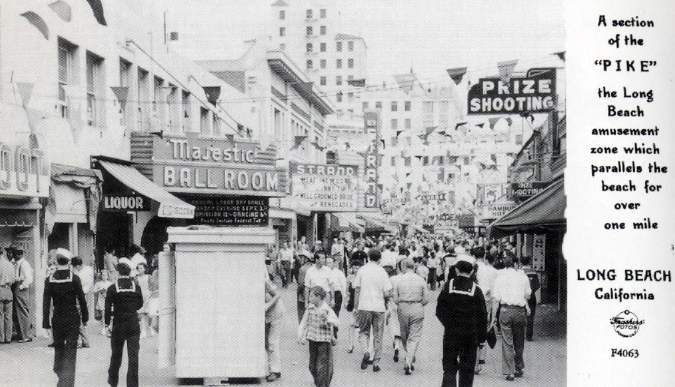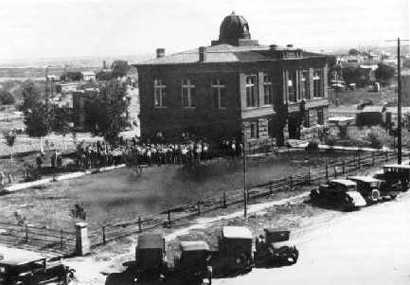This is the on-going saga of Uncle Alvin and friends’ trip from Minnesota to California.
 January 13, 1933
January 13, 1933 (continued) We then entered the lunch room, a large room equipped with lunch counters and tables where the parties ate lunch. After about a 30 minute stop we again started for a tour of the Big Room, a room over 4,000 feet long and 625 feet wide at the farthest part.

In places the ceiling was over 300 feet above us, and in places it was 600 or 700 feet above the floor below. The Big Room was by all means the most beautiful of any one in the cave. In places we saw pools of water in hollows in the floor. The stalactites and stalagmites assumed giant form in this room, too. There were giant chandeliers suspended from the ceiling in places along the room. We passed the Giant Dome which is about 60 feet high and 16 feet in diameter, but was connected to the ceiling. The Twin Domes nearby were almost as large and were true stalagmites. In places we saw pillars shaped about like a Santa Claus. In one place we saw the Giant’s Foot, with a large stalagmite for the big toe and four small ones for the other toes. At the end of this room we came to the Jumping Off Place,

which was a sheer cliff with a drop of some 300 feet. The floor below was lighted by electric lights, so we could gain some idea of how the second level looked. As the ceiling was some 300 feet above us the space before us was about 600 feet high. It must be said however, that we could not gain any comprehensive idea of the dimensions because everything seemed much smaller than it really was. On the way back, we passed by a pool that was actually 10 feet deep, but that really seemed to be only about two feet deep. In another place we passed right by a huge hole in the floor that had never been fully explored, and the true dimensions of which could only be estimated. It was believed to be over 300 feet deep though. Another interesting formation was a series of drip stones on the wall that seemed just like a waterfall. Most of the formations in the caverns were dry and non-growing, but in places they were wet and glistening, which was the sign that they were growing at the rate of one cubic inch per one hundred years so it can be seen that some of the formations must have been millions of years old. In one place a growing stalactite was dropping water at about the rate of one drop of water every 55 seconds. Some others dropped much faster, too. There was one stalactite that came within 1/32 of an inch of touching the stalagmite below it but then it stopped growing before they connected.
Later we came to a large rock that had been named “Rock of Ages: because of the fact that it was estimated to be about 50,000,000 years old.

We sat down there and all the lights in the caverns were extinguished. Then we heard the beautiful hymn “Rock of Ages”. After 30 seconds of absolutely total darkness the lights half a mile away were put on, then on closer circuits and finally the lights right around. It was really a most moving experience.
Then we walked back to the lunch room where we rested for a while, and where the party split up. Part of it (mostly men) began walking back, the others making use of

the elevator service, for an additional charge of 50 cents. The elevator itself is really a marvel of engineering, being 13 months in the construction, and being built from both ends. It was bored and blasted 750 feet through solid rock, in places being only about a hundred feet from the walls of a room. The surveyors had to measure about a thousand angles to find the correct places to drill from both ends. It is said there was an error of about ¼ of an inch when the shafts met. It cost something like $100,000 dollars.
The party walking back then left and went through the caverns at quite a rapid pace. We had numerous rest periods for it was really quite a climb back. We spent about five hours in the cave and traveled about seven miles.

We drove quite late that night so we could get to El Paso, where we rented a cabin for the night.
 Sunday January 22, 1933 The next morning being Sunday we slept a little longer than usual but got up in time to go to church at Trinity M. E. Church, which was the one the Lehnerts and Borchardts attended. The district superintendent was there that Sunday and preached though I was rather disappointed over the sermon itself. The singing was quite good but the most striking thing about it all was the very friendly spirit of all the people in the church. Everybody it seemed came up to us and shook hands and wished us well.
Sunday January 22, 1933 The next morning being Sunday we slept a little longer than usual but got up in time to go to church at Trinity M. E. Church, which was the one the Lehnerts and Borchardts attended. The district superintendent was there that Sunday and preached though I was rather disappointed over the sermon itself. The singing was quite good but the most striking thing about it all was the very friendly spirit of all the people in the church. Everybody it seemed came up to us and shook hands and wished us well. Most of them were hospital ships or others besides battleships and cruisers, though when we got out farther we came close to a battleship. They certainly were large ships and as we all know, very expensive. There were a few freighters and at least one passenger ship moving about in the harbor that day, too.
Most of them were hospital ships or others besides battleships and cruisers, though when we got out farther we came close to a battleship. They certainly were large ships and as we all know, very expensive. There were a few freighters and at least one passenger ship moving about in the harbor that day, too. We then walked through their amusement center there, sort of a Coney Island, and just looked the thing over for a while. There was nothing else to do so we went back home.
We then walked through their amusement center there, sort of a Coney Island, and just looked the thing over for a while. There was nothing else to do so we went back home.










































